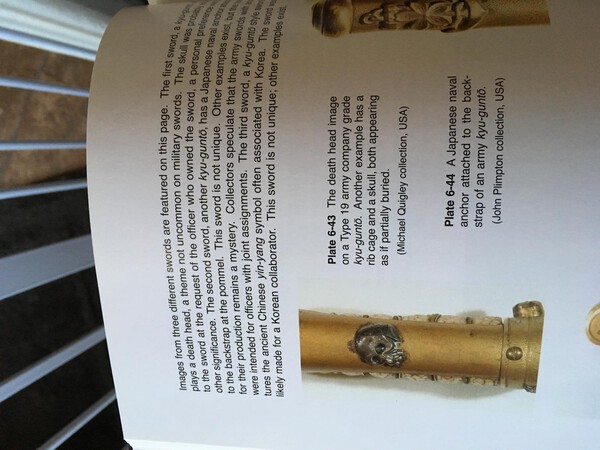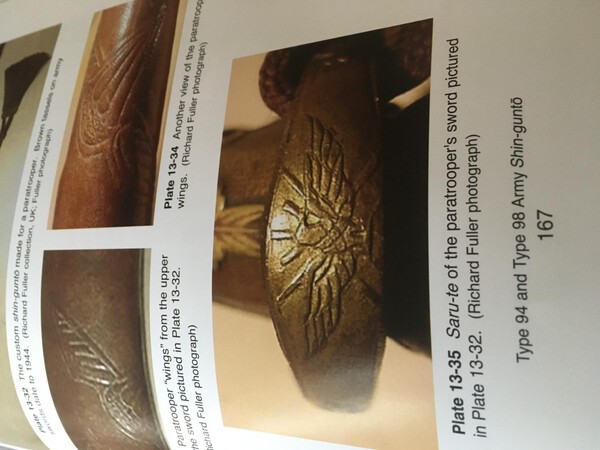-
Posts
12,938 -
Joined
-
Last visited
-
Days Won
154
Everything posted by Bruce Pennington
-
Kaka (interesting name in Spanish!), There is a "Seki" stamp above the mekugi hole, so it's made during WWII. If there is not date kanji on the other side, the exact year is a guess, but yes, probably 1940 or later. The Seki stamp appears to be the larger size. A small one means the blade is made in a non-traditional way, but the larger ones can be found on traditionally made blades. No guarantee, though, on that issue. Either way, you've got a nice WWII Japaese officer sword there!
-
Neil, my good man. I can see that this inconsistancy is troubling you greatly! In a totally selfless act, I propose you mail one of them to me, thereby removing the conflict and sparing you this suffering. Hurry, we don't want this to affect your health!!! In the meantime ... I certainly don't know the answer, but wanted to comment on the unusual kuchigane of the top one in the 3rd photo. Lends to your idea that there was a certain tolerance by acceptance inspectors for certain amount of variation. But back to your fretting ... you have my address, right?!
-
That is identical to one pictured on pg 76 if Dawson. He says “it was not uncommon on military swords” and “a personal preference with no other significance.”
-

Show Us Your High Class Gunto
Bruce Pennington replied to lonely panet's topic in Military Swords of Japan
Love that Type 3! Unusual leather wrap on the saya! You can see just from the curvature of the blade/saya that there is something special inside. -

Any Shin Gunto With "battle Scars"?
Bruce Pennington replied to PNSSHOGUN's topic in Military Swords of Japan
My guess is that the soldier wearing this had gotten some much unwanted attention! Wonder if he faired any better than the gunto did?! -
Truly gorgeous Doug!!! Thanks for sharing.
-

Help With Maker Marks On Wwii Sword
Bruce Pennington replied to Sakcollectors's topic in Military Swords of Japan
It's Spring 1944. You can read about Zodiacal dating method here: https://japaneseswordindex.com/kanji/zodiac.htm -

Help With Maker Marks On Wwii Sword
Bruce Pennington replied to Sakcollectors's topic in Military Swords of Japan
Seki stamp just under the Habaki. Handle looks like it was rewrapped at some paint - gold paint same’ and plain fuchi. It’s a Type 98 Officer sword. -
That’s a beauty!
-

Wwii Sword - Looking For Advice And Parts
Bruce Pennington replied to dsol's topic in Military Swords of Japan
You might want to send a PM to DaveR. He has some experience at refitting blades. I've heard some success stories, but I personally found it hard to do. Each blade has it's own curvature and size. Your best hope is to to get a complete set of Koshirae, as all the small parts are custom fitted to each other, and it's difficult to get individual pieces from here & there to all come together. My mantetsu has a locking latch that is missing the spring. I bought 3 lactches to replace it, and NONE of them fit! -
-
I’ve never found anything that will get the black spots off of the blade. For the seppa, I use a rag, pour a small amount of baking soda on the rag and squirt Lemmon juice into the baking soda. As it fizzes, rub the rust. It works slowly and takes some rubbing. I’ve never had to clean a tsuba and wouldn’t try the mix on it as it will probably take off the original coloration.
-
Sorry David, I was talking out of my butt! I've seen pictures of these but never seen one presented and broken down. The pictures show a naval saya and an army tsuka - clearly not a Rinji or one of the controversial post-war navy/army mixed ones.
-

Koa Isshin Mantetsu question
Bruce Pennington replied to obiwanknabbe's topic in Military Swords of Japan
Steve, The discussion you're thinking of was about a Rinji model because of the mekugi screw. This is new to me, too! But I've never owned one with the tsuka unwrapped, so I've never run into it. Very interesting! -
Brian, The collecting world has made some strides in the last 70 years in updating our understanding of WWII gunto. There is an extensive discussion of this style Army sword here: http://www.warrelics.eu/forum/Japanese-militaria/deflating-another-myth-type-3-army-officer-s-sword-expanded-version-584796/ But the short version is they were originally designed as a simpler, cheaper, and more hardy version of the Army officer gunto. It seems like they developed a fan-base, as several have valuable blades in them, and the fittings on some were clearly expensive upgrades. The Japanese of WWII didn't have a "marines" as we know it, but did have some Navy personnel who worked alongside the army on several of the islands. When they carried a non-standard gunto, in pictures that we have, they are the standard navy scabbard with an army handle on a naval blade.
-
That's a good price. High end for an officer gunto of today's market, but I believe the market is lower than it should be. But for an ealy war, gendaito, I think that's a really good price.
-

Going Price For Gunto Tassel
Bruce Pennington replied to Stephen's topic in Military Swords of Japan
CG: 150 USD seems to be the standard price FG: Bottom end 235, for something with a lot of wear/damage/fading; up to 500 USD for a pristine one GG: Don't see many for sale, but the one's I've seen run 1,000 USD -

My Shin Gunto From November 1943
Bruce Pennington replied to Old dog's topic in Military Swords of Japan
Yes, you have an excellent gunto for your first one! The Contengency style almost always come with good looking blades. I'm guessing the plasticized note is the translation of the surrender tag? If not, there are guys who can translate that for you. Are the fuchi (end cap of handle) and retention peg & screw missing? -

Ww2 Blade With A Seki Stamp And Kikusui Crest
Bruce Pennington replied to LakeBum's topic in Military Swords of Japan
No feathers ruffled, Jason. Just a "good conversation!" -
You can do a quick scan on fleabay and get a feel for pricing. 800 USD seems to be on the lower end of current officer gunto. I'd say 800-1,200 is the current range. So with a good re-wrap, you should be able to re-sell and make a small proffit, denpending upon how much you had to pay for the re-wrap.
-

Ww2 Blade With A Seki Stamp And Kikusui Crest
Bruce Pennington replied to LakeBum's topic in Military Swords of Japan
Ha, here we go, just like I said - stamps almost always lead to lengthy (and already held on other threads) debates! So a Seki stamp on EVERY (caps simply because I don't know how to underline on this format) blade means showato? I personally own, and have seen other guys' blades that are Star stamped, yet have a seki stamp on the nakago mune. So Showato? If so, what good is the Star stamp? -

Ww2 Blade With A Seki Stamp And Kikusui Crest
Bruce Pennington replied to LakeBum's topic in Military Swords of Japan
Jason, Stamps on nakago have created multiple discussions on multiple threads. The "general" fact is they were intended to identify blades made in non-traditional ways, including non-tamahagane gendaito. but there have been enough confusing blades found, clearly gendai, even STAR stamped, with stamps that have caused confusion. The Seki stamp is one of the most confusing, because it was originally designed by a swordsmith guild to mark their work. It was commandeered around 1942ish by the Nagoya Arsenal inspectors. George Trotter, a very knowledgable collector, says it was a guild mark and not a sign of showato: "from about 1941 the Seki swordmakers factories banded together in an association and insisted that they put on their own mark, "Seki". This was done...it is technically not an acceptance mark, but an ID mark for showato/gunto quality produced by the Seki Association." But even here, Trotter is saying the mark is for showato. I have also read (and could kick myself for not copying the discussion into my records) a discussion of the difference between "large" Seki stamps and "small" ones. His claim was that the large, like the one on this blade, was a guild mark, vs the small stamps that is a Nagoya inspector stamp on showato. This seems to fit this blade, if you ask me. However, this blade still COULD be "non-tamahagane gendai". -
Well, there's certainly a story that goes with this gunto. Without more info from your grandfather, all we have is speculation. All the parts are legit WWII Japanese, so no problems there. The arrangement is just odd. But gunto coming in from occupied lands are often non-standard. I don't know the history of Japan's troops in Burma, but in general, troops occupying islands and foriegn locations often had little to no logistical support. So repairs and parts often relied on locals. That's what I'm thinking when I see this. The majority of it looks to be a standard Type 98 with metal saya (scabbard). The tsuba (handguard) and ashi (belt hanger loop) fit this style. The fuchi (handguard collar) and leather retention strap look added, as does the leather cover. Gunto with leather covers over a metal saya usually rely on the metal spring-clip styled locking device, so one speculation is that the spring clip on this gunto broke, and the officer had a leather strap put on to replace it; but there would be a metal snap on the saya leather cover for it to attach to. So, that sort-of doesn't make sense. Another option is that there was a huge cottage industry at the end of the war, around the globe, putting gunto together from parts available to sell to G.I.s looking for souvenirs. This one has that look. Many swords were found on the battlefield without their scabbards. G.I.s and souvenir hunters picking one up, would simply match it to a scabbard the best they could find, to bring home (or in the case of the souvenir industry, replace missing parts like the leather strap, with what was on hand). It's a real piece of the war, and as such should be preserved and cherished.
-
Matthew, could I see a pic of the sword and scabbard on the other side - the side with the leather strap coming off the hand guard? Is there a snap on the leather scabbard cover by the leather strap?
-
Wow, I didn’t realize that was a leather cover! Knowing that - I’m surprised it is painted at all!!! Very peculiar! It’s not normal, as far as I know, to have the metal fittings like that on a leather cover. A knowledgeable expert on another forum uses a deer antler to scrape active rust off. He says it won’t harm the rest of the patina and tang. I’ll be never tried it. My wife gets antlers at the pet store for our dogs to chew.




